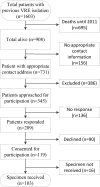Long-term carriage of vancomycin-resistant enterococci in patients discharged from hospitals: a 12-year retrospective cohort study
- PMID: 23926167
- PMCID: PMC3811615
- DOI: 10.1128/JCM.01501-13
Long-term carriage of vancomycin-resistant enterococci in patients discharged from hospitals: a 12-year retrospective cohort study
Abstract
Contact precautions are recommended in hospitals to prevent the transmission of vancomycin-resistant enterococci (VRE); however, there is no clear policy for how long patients should be under contact precautions due to a lack of information on the duration of carriage of these organisms. We conducted a retrospective cohort study to understand the duration of carriage of VRE (by screening of a single stool culture) and associated factors among patients who had been identified with VRE infection and/or colonization since the year 2000 at our health facilities. Of the 345 eligible participants, 136 did not respond, 90 declined to participate, and 16 did not send in the required specimens. Of the 103 remaining participants, 13 were found to have current VRE fecal carriage. The proportion of colonized patients fell from 40% (2/5) in the first year to 23.3% (7/30) in year 4. None of the 40 patients who had VRE detected >4 years prior were found to be colonized at the time of the study. The longest duration of detected VRE positivity was 46.5 months. Univariate analysis revealed that recent exposure to any antibiotics (P = 0.016), multiple antibiotics (P = 0.001), amoxicillin-clavulanic acid (P = 0.021), piperacillin-tazobactam (P = 0.007), glycopeptides (P < 0.001), meropenem (P = 0.007), aminoglycosides (P = 0.021), or fluoroquinolones (P = 0.021), being the index case in a clinical specimen (P = 0.016), and recent hospitalization (P < 0.001) were significantly associated with continued carriage on follow-up. In the surviving outpatients, a significant proportion appeared to clear VRE carriage. Our results suggest that in the absence of recent risk factors, such as hospitalization or antibiotic use, patients with a remote history of colonization (>4 years) may no longer require contact isolation precautions.
Figures


References
-
- Byers KE, Anglim AM, Anneski CJ, Farr BM. 2002. Duration of colonization with vancomycin-resistant Enterococcus. Infect. Control. Hosp. Epidemiol. 23:207–211 - PubMed
-
- Henning KJ, Delencastre H, Eagan J, Boone N, Brown A, Chung M, Wollner N, Armstrong D. 1996. Vancomycin-resistant Enterococcus faecium on a pediatric oncology ward: duration of stool shedding and incidence of clinical infection. Pediatr. Infect. Dis. J. 15:848–854 - PubMed
-
- Lai KK, Fontecchio SA, Kelley AL, Melvin ZS, Baker S. 1997. The epidemiology of fecal carriage of vancomycin-resistant enterococci. Infect. Control Hosp. Epidemiol. 18:762–765 - PubMed
-
- Henard S, Lozniewski A, Aissa N, Jouzeau N, Rabaud C. 2011. Evaluation of the duration of vanA vancomycin-resistant Enterococcus faecium carriage and clearance during a large-scale outbreak in a region of eastern France. Am. J. Infect. Control 39:169–171 - PubMed
-
- Baden LR, Thiemke W, Skolnik A, Chambers R, Strymish J, Gold HS, Moellering RC, Jr, Eliopoulos GM. 2001. Prolonged colonization with vancomycin-resistant Enterococcus faecium in long-term care patients and the significance of “clearance.” Clin. Infect. Dis. 33:1654–1660 - PubMed
Publication types
MeSH terms
LinkOut - more resources
Full Text Sources
Other Literature Sources

